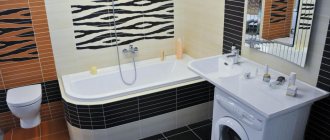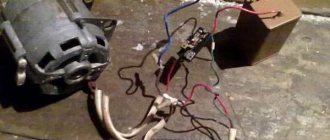I didn’t buy an automatic washing machine for a long time, because in the apartment the kitchen, bathroom and toilet rooms, due to the small area, did not allow installing even the smallest machine. Once, in a store, looking at car models standing on the floor, I noticed that to open the door I had to squat, which was not convenient. This is where the idea arose to make a shelf in the toilet behind the toilet cistern and place the washing machine on it. I had to choose a washing machine that was suitable in size and make a shelf for it.
Initially, the idea arose due to lack of space in the apartment, but even after moving to a larger apartment, I did not refuse to install the washing machine on the shelf behind the toilet. The advantages of this installation option: space saving, convenient access to the control panel, comfortable loading and unloading of laundry, reduced noise levels. The machine has been working on a shelf for more than 20 years and no shortcomings have emerged, except for the fact that difficulties may arise when placing the machine on a shelf, especially in a narrow toilet room.
Bowl design
Owners of small apartments are offered many options for placing a washing machine in the bathroom or toilet, but there are few solutions for the toilet, and they require careful consideration in finding suitable accessories.
If space allows, you can use the basic ones:
- machine and washbasin under a common countertop (this will solve the drainage problem and make it easy to remove the washing unit and sink pipes from view);
- a sink above the washing machine is no less productive, but this will also require a washing machine of reduced dimensions and a bowl of a special design that does not interfere with the operation of the device placed under it;
- a closet in the toilet above the toilet is a great idea, despite the widespread tendency to install the machine on the floor, but even here you will have to think carefully about the mounting system and vibration protection.
Important!
You can find a lot of advice on how to install the device in any other convenient place, but the lack of space often leaves the owner with no other options. But modern industry will help you choose a washing machine of the required height, with a side or vertical tab, a sink of any size with an ergonomic shape, and building materials to disguise the system of pipes and hoses.
There is an interesting proposal to use the space between the toilet and the corridor. If you choose a narrow unit with front loading, the thickness of the wall should be enough to accommodate half, and the second part of the device will protrude just the right amount to make loading comfortable.
The most successful solution from a safety point of view is the one with a wall-hung toilet and an almost flat plasterboard box for masking communications. Then the washing machine, complete with a sink-lily, can easily be placed near the entrance. But here you need to carefully select the parts of the kit and think through ways to supply electricity and water.
You may be interested in: How to choose tiles for the bathroom
Connection
How to connect the machine to all communications with your own hands?
Electricity
All modern washing machines use cold water for washing, heating it to the required temperature with heating elements. The exception is some rare Daewoo models imported to Russia in the early 90s. On the practical side, the presence of a heating element means that when heating water and rotating the drum, the power consumed by the device can reach 2.5 - 3 kW.
In addition, the washing machine operates in conditions of high humidity. If so, current leaks (in particular, the presence of a phase on a metal body) are quite real. If you connect the body of the machine when it is turned on to a faucet or a grounded bathtub, you will receive a very sensitive electric shock.
This has two practical consequences:
- For connection , a European socket designed for a current of 16 amperes ;
The permissible current is usually indicated on the front surface of the socket, between the holes for the plug pins.
The outlet is designed for a current of 16 amperes at voltages up to 250 volts.
- Grounding is required . Usually the earth is taken from the body of the shield. As a last resort, you can ground the outlet to a steel riser or cold or hot water supply. This is exactly how the machine in the Stalin building with old wiring, in which I lived for eight years, was grounded.
Grounding to the water supply. This is not entirely correct, but it is practiced.
Sewerage
The drain hose must be raised to a height of at least 50 cm from the floor . The instruction is related to the absence of a shut-off valve on the drain of a typical washing machine: if you lower the hose lower, the water will begin to flow out of the tank by gravity.
How and to what can I connect the drain hose?
- To a separate outlet of plastic sewerage with a diameter of 50 mm;
- To a 50x50x50 tee installed in the gap of the comb (indoor sewerage);
The machine is connected to the sewer through an oblique tee installed under the washbasin.
The bend and straight tee are usually equipped with a vertical pipe 40-50 cm high. Its upper edge is rigidly attached to the wall. The goal is to prevent the hose from falling below the notorious 50 cm above the floor.
- To a siphon with an outlet for a washing machine under the washbasin;
The hose is connected to the siphon.
- Finally, the hose with the bracket that secures it can simply be hung on the edge of the bathtub. Of course, in this case, washing cannot be combined with taking a shower.
An important point: the connection between the sewer pipe and the hose must be sealed , otherwise the room will be saturated with unforgettable aromas of wastewater. For sealing, you can use rubber sealing couplings sold specifically for this purpose, or any available material, even tape.
To seal the connection, I used polyethylene foam left over from insulating pipes in the basement.
I strongly advise against drilling a hole in the riser and inserting a hose into it. The tip of the hose sticking out inside the riser will collect any large-sized debris traveling through the sewer - paper, rags dropped into the toilet and other unappetizing things. Sooner or later this will lead to a blockage, and both the neighbors above and you will suffer: the slab floors are not airtight.
This connection to the sewer is not a good idea.
Water pipes
The standard hose for connecting the washing machine to the water supply ends with a union nut with a pipe thread size DN20 (3/4 inch).
Inlet hose for connecting the washing machine to the water supply.
The modern market offers many taps of this size.
A couple of recommendations for choosing a faucet:
- A ball (closed by turning the handle 90 degrees) is much more reliable than a screw (closed by a few turns of the knob);
- The larger the handle, the more convenient it is to open and close the tap. When idle for a long time, it turns with noticeable resistance, and the long lever of the handle will be very useful.
The photo shows a good, serviceable straight-through valve.
Instead of a specialized tap, you can install a regular ball valve with an adapter DN15 - DN20 on the outlet for connecting the machine.
Where can I install a tap to connect the machine with minimal modifications to the water supply connections?
- On the tank's liner. To do this, place a tee size DN15 or a standard straight-through tap in front of the flexible hose;
- On the liner to the washbasin. The connection is completely similar to that described above;
Connection to the water supply with a pass-through tap.
- In front of the wall-mounted faucet in the bathroom. The pass-through tap for connecting the machine is installed between the corner or water socket and the cam (eccentric) of the mixer. A so-called extension (pipe with external and internal threads) of the same length as the pass-through valve is mounted on the second connection;
Insertion in front of the mixer. Connection takes no more than half an hour.
- After the valves, you can cut into the steel liner by replacing the coupling on the outlet with a tee size DN15;
Instead of a coupling, a tee is installed.
- As a last resort, you can use a saddle for insertion - a clamp with a water outlet. With the cold water supply valve closed, a hole with a diameter of 6 - 8 mm is drilled in the pipe, then a clamp with a rubber gasket is attached to the pipe and equipped with a tap for connecting the machine.
Brass saddle for inserting into a pipe.
Toilet area 2 sq. m
According to designers working in limited space, 2 squares is too large an area to accommodate one toilet, so there are many successful and unsuccessful projects with the placement of a sink, shower or built-in cabinet.
There are even options with a wall-hung toilet, washing machine, sink and hygienic shower.
However, you need to understand that all this is done in the style of constructive minimalism. In such an area, a toilet with a washing machine and a sink can only be placed in the three above options, and for this you will have to use components of a certain type:
- the sink above the washing machine can be purchased from one manufacturer in a ready-made kit, adjusted to the standard sizes;
- the standard height of 85-90 cm will not work here. This will create inconvenience for washing for children and small people, but there must certainly be at least a small distance between the bowl and the washing machine;
- a sink above the toilet in a small toilet is also a bad solution, because it is inconvenient;
- The best option is to purchase a washing machine with a height and width of up to 60 cm, and a depth of no more than 45 cm. Such equipment is more expensive, but it will justify its purchase by saving space and ease of placement.
Note!
The photo shows a sink designed to be installed above a washing machine. It received the name water lily because of its special shape: a flat bottom and minimal recess. Therefore, the drain in such models is often located closer to the rear wall to prevent splashing.
You can save space by choosing this item for a corner placement or a rectangular shape. The oval one will help avoid injury that is inevitable if you place the washing machine and the sink above it dangerously close to the toilet.
Offers from manufacturers differ in color and shape, but there is not much room left for limited space. You can place a heated towel rail above the toilet, but this is practically the only option to complement the minimalist, shrunken design.
Implementation
The standard option is to install a standard toilet with a cistern, and make a shelf for the washing machine above it. I think there is no need to explain here, the main thing is to make the shelf strong and rigid so that it can withstand vibrations and heavy weight.
The simplest, but not reliable option is mounting on brackets
If the machine stands high, it is inconvenient to pour the powder into the tray. You will either have to stand on the toilet (dangerous), or remove the tray each time, or pour it directly into the drum.
A more advanced option is to use a wall-hung toilet. Then you can put the tank behind the machine and lower it lower for ease of access. There is no need to sew up the installation tank tightly and it will be accessible in case of repairs. Since the drain button will be behind the machine, you need to come up with some kind of drive for draining.
There is a plastic tank behind the washing machine.
We cut the installation frame in half and weld it with a profile pipe into a table like this. If there is no welding, you can tighten the structure with bolts
It is important to make a shelf higher than the toilet lid so that you can install swing doors later
Frame from installation
It is better to place the machine on rubber pads so that the structure vibrates less.
The flush tank should not be placed too high, because there will be strong pressure and water will pour out of the toilet.
The sides will be covered with plasterboard. On the side there is a water outlet for a hygienic shower with a thermal mixer.
Don't forget to install a drain for the machine. The installation height of the drain can be found in the instructions for your machine.
To control the drainage, an electric drive with a servo machine is installed. A backup option in case of drive failure or power outage is a pulling rope.
Servo
The operation scheme is as follows: press the wall switch, the microcontroller power supply turns on. The microcontroller turns on and commands the relay to supply 220 volts to the servo. The wall switch can be released immediately. The microcontroller smoothly starts the servo drive, it presses the drain button.
If you don’t want to bother with Arduino, you can find an installation with an air-driven drain. Grohe and Geberit have these - the drain button can be placed anywhere.
Toilet with washing machine and sink
According to some designers, there is only one option for this design - placing the washing machine above the toilet and a corner sink. However, this is an idea that creates difficulties in implementation - you will have to take care of creating a structure that is reliable enough to withstand the weight of not only the washing machine, but also its contents. This creates a considerable risk of injury for the person sitting on the toilet and discomfort when operating the device.
You may be interested in: Small bath 4 square meters: arrangement and decoration, modern design
As an example, you can use the design of a small bath without a toilet with a washing machine and a sink. The most convenient option is a washing machine of non-standard dimensions with a complete sink from one manufacturer and a wall-hung toilet, which is moved to the place of a banal built-in cabinet that hides unaesthetic plumbing pipes.
The main advice from the experts is to carefully measure the dimensions of the room, draw up a layout diagram accurate to the centimeter and thought out from the point of view of ergonomic use. You will have to spend a lot of time searching for the right device and installing it, but this will bring the necessary space savings. In order not to waste time going to shops and supermarkets, you can search in online stores or on manufacturers’ websites.
In the kitchen
This is the second most popular place in the house to place a washing machine. Here it is also easy to connect it to communications. In addition, the kitchen is larger than the bathroom, making it easier to find space for a car here.
The washing machine can be placed under the sink, next to the countertop or in one of the cabinets.
Place a rubberized mat near the machine - this will protect your laminate from moisture.
Alternatively, just hide it behind a curtain.
Modern technology can fit even into the most romantic interior.
If you don’t want to hide the washing machine behind the doors, you can match it to the color of the kitchen unit - this way it will maintain harmony in the kitchen interior.
A black washing machine can be washed less frequently.
Beige or blue furniture looks good in combination with blue appliances.
Choosing a style in 2021: ideas
Limited space, used with maximum economy, does not leave much room for choice of style. The main direction is constructive minimalism: no unnecessary details or objects, a calm palette of gray and white colors. Using decorative tiles made of natural stone or imitating it, it is possible to create a semblance of a loft style. If you place a contrasting panel on a free wall, you will get a modern or art deco look. Of course, for each style you choose, you will have to look for a matching sink and toilet. Their choice is already limited in size and shape, but with some effort you can find suitable ones.
If you have a limited budget, it is recommended to use economical offers, for example, photo or washable wallpaper, plastic. Light colors will visually expand a small room, textiles will create an inappropriate impression of being busy, but the rug will be appropriate from a design point of view and for reasons of safety and convenience. For hygiene purposes, it is better to use an easy-to-clean one that does not collect dust and dirt, with a cutout for a standing toilet or a rectangular one of the required size.
Disadvantages of wall construction
One way or another, wall-mounted models physically cannot provide high quality washing. This is not a death sentence at all, but today the maximum quality class for such models is B. It is quite possible that in the future this level will increase, as has already happened with the spin and rinse characteristics. But if the wall-mounted washing machine can be further developed to perform its main function, then the volume of the drum will remain the same. Minor changes, again, are not excluded, but the installation method in the form of wall mounting will not allow manufacturers to significantly increase capacity. Consequently, a loading volume of 3-4 kg is the maximum for machines of this class.
Another unpleasant disadvantage of the new models is the cost. To begin with, it should be noted that models in a traditional form factor with modern technical fillings are estimated at 10-15 thousand rubles. It is difficult to say to what extent the capabilities of such models exceed the technological advantages of wall-mounted washing machines. The price of such modifications is about 16-20 thousand rubles.
Choice of colors: current colors
White is considered the most popular. If you watch a video with offers from construction supermarkets, most plumbing fixtures are of this color.
The designer still has the opportunity to decorate the toilet using decorative tiles on the floor and walls, drywall, and decorative plaster. If you use beige, golden, blue and light green, you can also choose plumbing fixtures in these colors, but this year the dominant colors are lilac, metallic, burgundy and blue.
On a note!
Don't forget that fashion changes. It’s better to choose a traditional color than to be nervous about the chosen acid-bright color and think about changing it.
The color scheme can be created using only a floor mat and a panel on the side wall - it all depends on the taste and competence of the home designer.
Features and advantages of wall-mounted washing machines
Despite the fact that the first wall-mounted models of washing machines appeared back in 2012, most users learned about their existence only recently. Basically, their characteristics are not much different from those of traditional floor-standing models. And all the restrictions are caused only by increased compactness. Among the advantages of the new product, many highlight:
- very quiet operation of the washing machine;
- complete absence of vibration;
- convenience of filling the drum;
- efficiency;
- ergonomics and unique design.
The only disadvantages include the small capacity of the drum and not the highest washing class. Also, many consider the rather complicated installation of wall-mounted washing machines to be a disadvantage.











